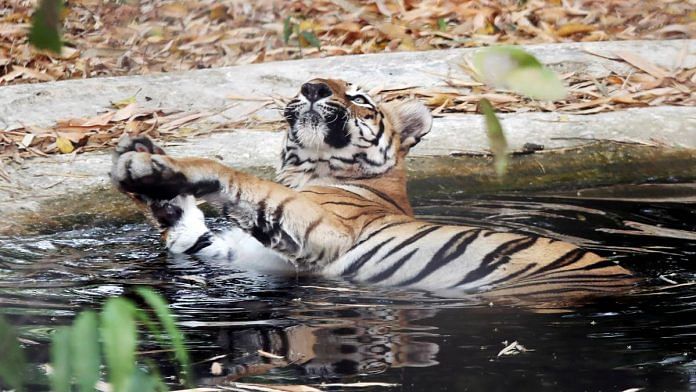Bhopal: Moving forward from the debacle of the past, governments of Madhya Pradesh (MP) and Odisha are once again in talks to translocate three tigers from MP to the Debrigarh Wildlife Sanctuary in Odisha.
In March 2021, the country’s first inter-state tiger translocation project had come to a tragic end when the tigress Sundari was tranquilised and sent back to MP after spending 28 months in captivity in Odisha’s Satkosia Tiger Reserve. She was believed to have killed two persons.
The translocation project had been rolled out in June 2018, with the sub-adult tiger Mahavir shifted from MP’s Kanha Tiger Reserve to Odisha’s Satkosia Tiger Reserve. The tiger was then joined by the 27-month-old Sundari from MP’s Bandhavgarh National Park for “augmenting and recovery of the tiger population in the Satkosia reserve”.
The idea behind the project was to shore up the tiger population in Satkosia, but the relocation of tigers led to protests from those living on the fringes of the reserve, and in November 2018 Mahavir was found missing. His carcass was found a week later.
In September and October of the same year, Sundari was believed to have killed two persons. She was later shifted to an enclosure and spent the next 2.4 years in captivity before being sent back to MP in 2021.
Now, once again with a view to establish a viable tiger population in Debrigarh, Principal Chief Conservator of Forests (PCCF), Odisha, Susanta Nanda, has sought three healthy tigers, one male and two female, about two to three years old, for translocation to the Debrigarh sanctuary.
Debrigarh Wildlife Sanctuary in Bargarh district of Odisha is connected to Sunabeda (a proposed tiger reserve) and to Udanti-Sitanadi Tiger Reserve of Chhattisgarh.
Nanda has requested for the three tigers in a letter to Madhya Pradesh Chief Wildlife Warden Alok Shrivastava, following the approval of the technical committee of the National Tiger Conservation Authority (NTCA). ThePrint has a copy of the letter.
Speaking to The Print, Nanda said: “Unlike Satkosia, Debrigarh is an inviolate area with a very good prey base, owing to which we sometimes have tigers from the central Indian landscape visiting here. The translocation request for tigers can be seen as a species recovery, as there were tigers here in Debrigarh earlier but have gone extinct locally now.”
Nanda highlighted that as the Standard Operating Procedure states that tigers for translocation have to be geographically and genetically close, they have sought tigers from Maharashtra, Madhya Pradesh and Uttarakhand after having done appropriate genetic study.
Speaking to ThePrint, a senior official from the forest department of Madhya Pradesh said: “Considering the past experience with Odisha, the forest department has sought prey base and habitat analysis data from Debrigarh Wildlife Sanctuary, and after being satisfied with it, a call on transferring the tigers will be taken.”
The officer added that along with Odisha, the Madhya Pradesh government had received requests for tigers from Rajasthan and Chhattisgarh too.
With 785 unique tigers, Madhya Pradesh has the highest tiger population in India, according to the latest tiger census data released last year.
Also Read: Tiger conservation body seeks clarity on SC stay on construction within reserves, national parks
‘AI-powered cameras to monitor animals’
Both Maharashtra and Madhya Pradesh, Nanda pointed out, are states with heavy population of tigers and these excess tigers looks for shelter in adjoining areas. These areas where the tigers are moving to are states like Odisha and Chhattisgarh.
“As a result, at present, we have two tigers in Odisha who have wandered in from MP and Maharashtra. We have received approval (for the tiger request) from Uttarakhand, but are waiting to hear back from Maharashtra and Madhya Pradesh,” he told The Print.
According to Nanda, what makes Odisha better equipped at handling the tigers this time is the use of sophisticated AI-powered cameras, the first-of-its-kind, that have been installed in Similipal Tiger Reserve to monitor forest fires.
Another forest official from Odisha elaborated the point. “In Satkosia, before Mahavir was found dead, the forest officials had lost track of him for about a week. But with these AI-powered cameras and towers that are scanning 360 degrees of the forest will allow forest officials to zoom in on a forest area soon after receiving signal from a radio-collared animal. This will ensure 24×7 monitoring. It is a one-of-its-kind technology in India which has been introduced in Similipal and will be replicated in Debrigarh,” he told ThePrint.
In the wake of several requests for tigers, the MP forest department in a letter to all its Divisional Forest Officers has sought a list of tiger population in their respective areas, along with details of any tigers that may create trouble or indulge in territorial fights, those that are breeding and those that are young.
Just last month, a 62-year-old man identified as Maniram Jatav was killed by a tiger in Obaidullah Gunj of MP’s Raisen district, merely 20 km away from the city limits of Bhopal. It is the first reported incident of a tiger attacking a human in the vicinity of Bhopal in several decades.
A divisional forest officer, confirming the same, told The Print: “According to the request of the headquarters, we have submitted the data on tigers and are awaiting further instructions.”
(Edited by Nida Fatima Siddiqui)
Also Read: Why tiger reserves see ‘less deforestation, carbon emission from forest loss’ than protected areas






